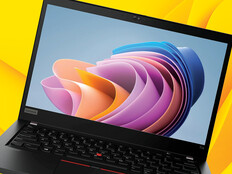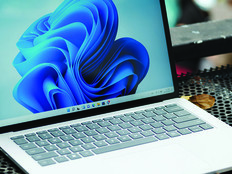Think Sturdy
Finding a balance between portability and power has been an ongoing challenge for notebook manufacturers — and for demanding computer users. There’s always been a class of computer users who aren’t easily served by a notebook.
The challenge is raised further when you need a system capable of handling tasks such as displaying high-resolution geospatial imagery or working with 3D computer-aided design and rendering tools in the field. How do you pack the computing horsepower needed for those applications into a notebook?
The answer, in the past, has usually been “with difficulty.” But improvements in LCD-based displays, storage and processor technology have made high-performance portable computing possible, unchaining high-end graphics, image-editing and engineering apps from the desktop.
A prime example of this new generation of powerful portable computing is Lenovo’s ThinkPad W700. The “W” stands for “workstation” — because the target users are people running high-end graphics and imaging applications. That makes it ideal for many government applications, such as geospatial imaging and image analysis, and processing intelligence, surveillance and reconnaissance data. With a high-resolution 17-inch display, 64-bit processing power and disk storage that rivals many desktop PCs, the W700 is a good fit for mobile power users.
Advantages
The ThinkPad W700 has a lot to make users happy beyond horsepower. Besides features that come standard on the current generation of notebook computers — built-in video camera and microphone, keyboard lights and stereo speakers — this system has a number that you’d expect only in a desktop.
For starters, it has a full-size keyboard with a separate numeric keypad, making high-volume data entry a lot less cramp-inducing. There are multiple pointing devices built into the system as well. In addition to a touchpad and the trademark ThinkPad Isopoint pointer (which translates finger pressure into mouse movement), there’s also a built-in Wacom digitizer and pen for precision pointing, drawing and image editing. The pen stores away in a recessed compartment on the right hand side of the keyboard and springs out with a touch.
There are also plenty of places to plug in more devices. The system has five USB ports and a 1394 (FireWire) port for plugging into external devices, plus an eSATA port for connecting external storage devices. It also boasts multiple display outputs, including VGA, dual-link DVI-D and digital DisplayPort (a digital video connector comparable to HDMI). The W700’s onboard NVIDIA graphics controller drives all of these.
There’s also a 7-in-1 multimedia card reader, which accepts compact flash and other storage card types, allowing for easy transfer of digital images and other data from cameras and sensors. And the built-in Blu-ray DVD drive can read and write to optical disks.
But all those features wouldn’t matter without the computing horsepower to drive them. The configuration I tested came with an Intel Core2 Duo processor — two 64-bit processors on a single CPU, running at 2.8 gigahertz. The system came preloaded with the 64-bit version of Microsoft Windows Vista Business, and 4 gigabytes of RAM, as well as dual 200GB hard drives. (The W700 will support up to 8GB of RAM, and there are also a number of other drive configurations, including one with a solid-state drive.)
The net result was that large 3D models, images and geospatial applications such as Google Earth ran as fast as on any desktop. The system scored a 5.2 on Microsoft’s Vista Experience index — though its 3D and standard graphics both ranked significantly higher than that, at 5.8 and 5.9 respectively. The lower score was based solely on its disk I/O performance — still well above that of most notebook computers and comparable to most midrange to high-end desktop drives, making it quite a viable desktop replacement candidate.
Backing up all that horsepower is more-than-generous battery capacity. I was able to run the system at high-performance power management settings, with multiple network and disk-heavy apps, for more than an hour and a half. With power management enabled, it chugged along at more than 4 times that in run-time, and the system was still at 40 percent power after five days of stand-by mode.
Why It Works for IT
There are a number of features built into the W700 that will please IT managers and administrators. The system includes biometric authentication capabilities, using a built-in fingerprint scanner. It also has full-disk encryption to lock down data — a must for mobile and teleworking feds.
The ThinkPad W700 provides high-end graphics workstation features and performance in a notebook form factor.
There are also built-in information-assurance capabilities. The dual hard drives can be run in RAID mode, providing a high level of data protection. Or, using Vista’s built-in backup capability, an internal drive can be used for system backups, giving the user the ability to quickly restore lost or damaged files. The eSATA and 1394 interfaces also make it easy to connect to external backup devices to ensure valuable data isn’t lost.
The built-in LCD display, with 1920x1200 pixel resolution, also comes with integrated Pantone color calibration. By activating the calibration software and closing the screen, a user can restore the screen to a standard color profile without technical support.
Disadvantages
The main trade-off for all this power and high-resolution glory is size and weight. The ThinkPad W700 weighs in at 8 pounds. And its 17-inch screen doesn’t exactly make it a candidate for comfortable airplane tray use.
And though the W700 may pack the capabilities of both a notebook and a desktop into its sturdy ThinkPad form factor, it costs significantly more than comparable desktops. Depending on the features, the system comes in a range of prices, from just less than $3,000 to more than $5,000 for a fully loaded version. The W700 is truly for those who need portable power and aren’t afraid to spend a little extra to get it in a form that doesn’t include a wheeled cart and an extension cord.







